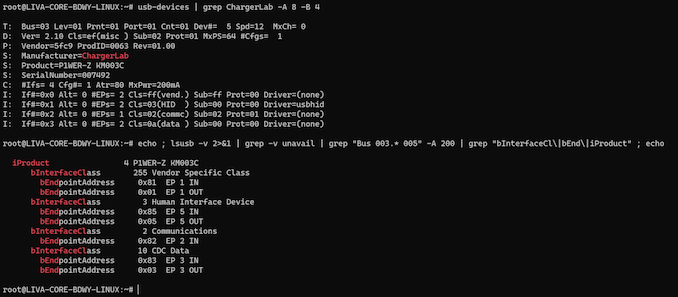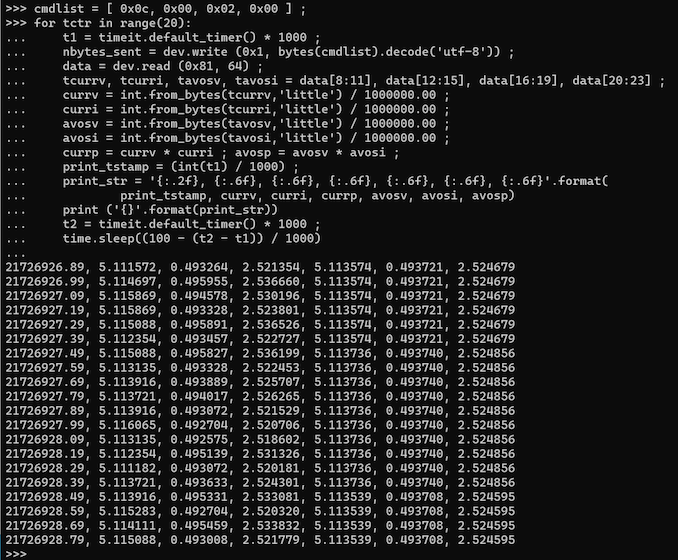USB-C Power Metering with the ChargerLAB KM003C: A Google Twinkie Alternative?
by Ganesh T S on July 5, 2023 8:00 AM EST- Posted in
- Gadgets
- USB PD
- Power Assessment Tool
- USB-C
API Access on Linux
Our current USBC-TKEY-based setup for measurement of power consumption uses a Ubuntu 20.04 machine for tracking the parameters on the VBUS line. Since the USBC-TKEY has a command line interface accessed over the serial port, we had developed a Python script to record a CSV file with the required data. In order to experiment with the APIs provided by ChargerLAB for the KM003C, a SanDisk Professional PRO G40 Thunderbolt 3 portable SSD was connected to a Thunderbolt 3 port of a Quartz Canyon NUC with the KM003C acting as a man-in-the-middle (additional details in a later section discussing the KM003C in action). The HID port of the KM003C was connected to the Ubuntu machine using a Type-C to Type-A cable.
The API document makes a note of the KM003C presenting itself with three bidirectional interfaces. As only Windows support is claimed, it is no surprise that only the HID endpoints get exposed via the usbhid driver. The WinUSB endpoints belong to a vendor specific class, and the virtual serial port appears as a CDC data interface.
In exploring the KM003C as an alternative to the USBC-TKEY, we wanted to retain the Python script infrastructure (because it tied in well with the other components of our direct-attached storage evaluation infrastructure). It turned out that Python's libusb module could act as a WinUSB alternative with its ability to access the endpoints under the Vendor Specific Class. This module requires the end user to be aware of the raw data that needs to be sent across the interface, and the format in which data is returned on the other endpoint.
The relevant modules to import in Python3 for libusb support are usb.core, usb.util, and usb.control. Since the vendor and product ID of the KM003C are known from the output of the usbdevices command, they are used directly to open the device for access through the script. Reliable scripting needs to ensure that the device is successfully found. For demonstration purposes, the variable contents are displayed, as shown above.
While the libusb module aims to be cross-platform, we did find that the steps below to detach the kernel driver did not work on Windows. libusb needs exclusive access to all the interfaces over which communication is expected to take place. For demonstration purposes, the code extract above cycles through a hard-coded number of interfaces (4), but it is possible to obtain that number from other functions in the module. The extract checks if an interface has a kernel driver attached to it, and detaches it in that case. It then proceeds to claim the interface for access through the script's session.
In order to retrieve the power consumption data from the device, a command needs to be transferred via the EP 1 OUT endpoint (with endpoint address 0x01). As ChargerLAB mentions, we can also use the EP 5 OUT and EP 3 OUT ones at addresses 0x5 and 0x3, but the response needs to be monitored at the corresponding EP IN endpoint. The command itself is in the form of a 32-bit word, and its encoding is detailed in the API document. In the script extract below, the 32-bit word is 0x0C000200. It corresponds to a GET_DATA command for the ADC data with a command ID of 0x0. I found during the course of experimentation that the ID in [23:16] could be varied from 0x0 to 0xFF without any loss in functionality. Since the command remains the same throughout the reading loop (we attempt to read out the power data 20 times with a gap of 100ms between each read), the command word is initialized outside the loop.
The first step in the loop is to obtain a timestamp for the command written out to endpoint address 0x1. This write is followed by the read to endpoint address 0x81 (the EP IN corresponding to the EP OUT used in the write). The read is blocking, i.e, it waits for the data to be sent back by the device and there is a default timeout associated with this command. The received data is then parsed out into appropriate components (instantaneous VBUS voltage and current, and the averaged VBUS voltage and current) based on the struct specified in the API document.
The HID demonstration code (supplied as a Visual Studio 2019 project) tagged along with the API document read out the averaged voltage and current. The documentation did not specify the averaging duration or the sampling rate. In the initial trials, the code did not read out the instantaneous values, and I was left frustrated as to why the averaged value was changing only once every second instead of getting updated for every read out. I spent quite a bit of time trying out the same code with different endpoints, and even different OSes. I even went to the extent of using Wireshark along with usbpcap in an attempt to trace the commands sent and data received by ChargeLAB's closed-source Windows software. It was only after careful analysis of the packet capture did I realize that the average VBUS voltage and currents were changing only once ever second even in the traffic triggered by the software. The instantaneous data of interest actually turned out to be the first two words in the returned ADC data struct. The time taken for the read process and display of the CSV data is computed and the code segment is left idle before starting the next loop iteration 100ms later. Each line in the output data stream shows the timestamp, instantaneous voltage, instantaneous current, and instantaneous computed power, followed by the averaged versions of all three. Given the details of the averaging process, it is possible that the computed averaged power consumption can also be interpreted as the energy consumed by the sink (device, in this case) since the last change in that parameter.
As a final step in the script, a cleanup is performed so that all open accesses to the device via libusb are flushed out, and the device is made accessible to other programs. The script can then be terminated safely.















20 Comments
View All Comments
ganeshts - Thursday, July 6, 2023 - link
The 50V and 6A are independent of each other. USB-PD 3.1 goes up to 48V / 5A, but other fast charging protocols can differ. For example, SuperVOOC 2.0 operates in the 3-10V / 0.1 - 6.5A range [ https://www.oppo.com/content/dam/oppo/en/mkt/newsr... ].The KM003C supports a long list of non-USB-PD fast charging protocols, and it looks like 50V and 6A are the maximum it supports for the voltage and current on the VBUS line.
lucaB75 - Friday, July 7, 2023 - link
55-110 bucks ? Come on , dont waste time on these reviews, we need real news not bs (highly)overpricedThreska - Friday, July 7, 2023 - link
"Despite this premium pricing, we believe that the KM003C should be part of every USB-C power user / developer's toolkit."Or people who regularly buy questionable chargers and cables.
meacupla - Friday, July 7, 2023 - link
With the way this tester is costing, you might as well buy from a reputable brand to begin with.I am pretty sure you can get an Anker USB GaN charger, with Anker 100W USB cable for $55~110.
TomWomack - Friday, July 7, 2023 - link
And that gets you one charger; we have at least one charger in every bedroom plus a couple on every desk, and spending $110 once on a device which lets you determine which $20 charger it is reasonable to buy a dozen of makes reasonable sense.TheinsanegamerN - Monday, July 10, 2023 - link
If you have enough expensive power hungry devices that you have to have 100w charging in every room, just buy decent chargers and be done with it.Bp_968 - Thursday, August 3, 2023 - link
This device is massive overkill for testing your portable USB battery or USB wall wart. You can do the same thing for 20-30$ if that's all you need it for. But this device will do far more then simply tell you if the battery can output 15 or 20v and at what amperage it can do so.It's like saying an oscilloscope is overpriced because you can use a much cheaper multimeter to see if your home outlet is putting out the correct AC voltage.
PeachNCream - Saturday, July 8, 2023 - link
Anything that lets you escape Google's revolting, mustache-twirling, sticky-fingered clutches is a good thing. It's always a pity to see the US sit idly by while Google feeds the population free candy in exchange for the entirety of the nation's personal data. At least the EU, problems noted where relevant, acts against disgusting data fetishist activity through GPDR enforcement that has teeth. Were it not for sucking from Google's four coloured teats at all levels of governance, the company could have been broken apart by now along. But who am I to complain? You let Elon Musk, Justin Bieber, and that sensationalized scammer-philantropist MrBeast all obtain fame while polluting the world for everyone by driving one and only one person with no cargo whatsoever in a enormous pickup truck or SUV. It's the US after all.Fury13 - Tuesday, July 11, 2023 - link
Is there any (affordable) hardware product available to monitor USB-C bandwidth so we view bandwidth of products such as web cams / VC systems / SSD's to PC's?I understand Crystal Disk Mark can work with a SSD, but this is not the only device I'd like to validate.
Ramalama - Saturday, July 22, 2023 - link
I own the KM003C since around 1 Year...And bought it on AliExpress for less as 50€.
Wondering why this review comes so late tbh.
However, this thing is really great, i have others like the CT-3, which is great either!
Tbh, the only difference is EPR, for example if i measure my MacBook Pro with the ct-3, it will limit the charging to 100W.
No matter what you do, your MacBook will never charge higher as 100W
If i use the KM003c, the MacBook will charge at full 140W.
But for everything below 100W there is literally no different between the ct-3 and KM003c...
Just that the one has usb-a and the other usb-c...
They are both very precise. Actually they work really great!
Would i recommend to buy one of those?
No! Why?
Because you literally use it once you buyed to play with and after some days you will never need it and forget where it even is.
Cheers